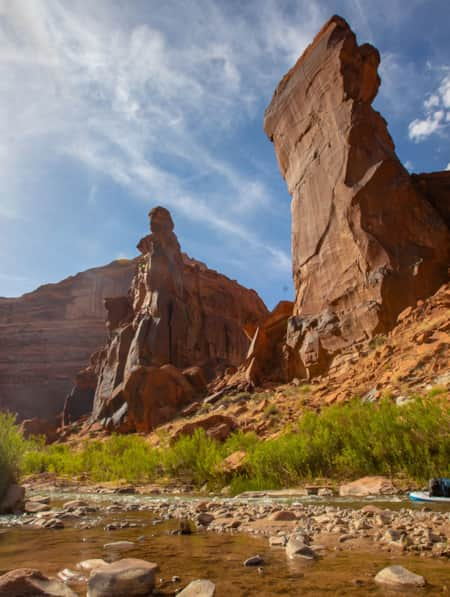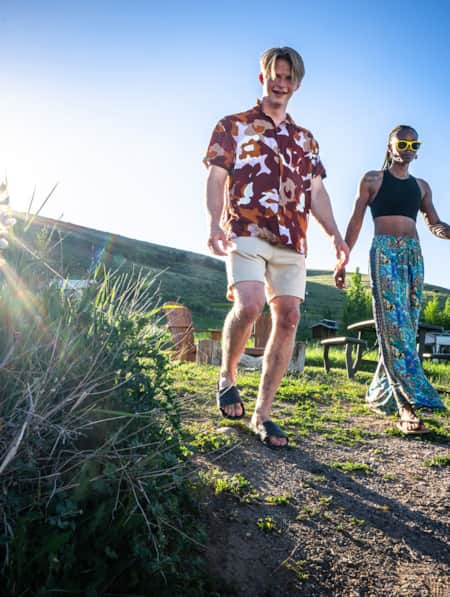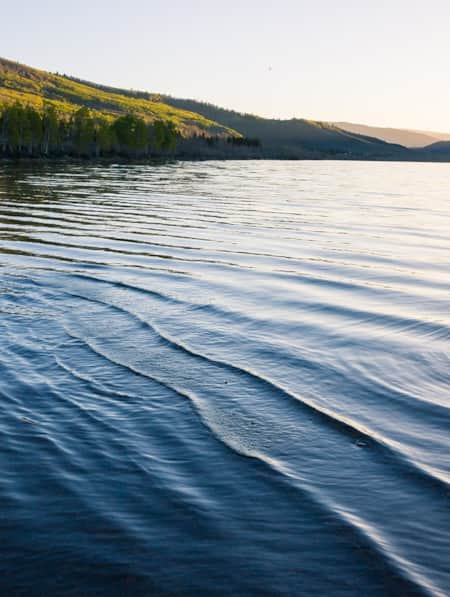A Life Elevated Road Trip
Hit the road with Aaron Millar, host of The Armchair Explorer podcast, as he takes an adventure tour of Utah — complete with audio postcards along the way.

You've probably seen countless pictures of Utah's spectacular landscapes and world-class adventures — but have you heard them?
Aaron Millar, host of The Armchair Explorer podcast, invites you on a sonic adventure with his one-of-a-kind "Utah: Life Elevated" series. Over nine days, Millar embarked on an epic road trip across Utah, capturing the essence of the state in immersive audio. From the rush of white-water rapids to the awe of discovering dinosaur fossils, these sounds transport listeners to the heart of Utah's wild beauty. Let his journey inspire your own Utah adventure.
He's captured every thrilling moment, all recorded in stunning surround sound. So close your eyes and imagine yourself:
- Launching off an Olympic ski jump into a swimming pool.
- Mountain biking with a pro.
- Riding white water rapids while fishing for giant trout.
- Uncovering ancient dinosaur bones.
- Getting lost in the glow of the Milky Way.
- Canyoneering alongside the ghost of Butch Cassidy.
- Exploring Native American culture at Bears Ears.
What Does it Feel Like to Ski Jump into a Swimming Pool?
I’m standing on top of an Olympic ski jump, about to soar 30 feet into a swimming pool. Yes, you read that right: a swimming pool. My hands are shaking, and my breathing is fast. In the rush of adrenaline that follows, I barely hear myself scream.
This thrilling moment marks the beginning of my road trip across Utah. Traveling in a roughly 1,000-mile loop from Salt Lake City to Monument Valley and back, I will be rappelling into slot canyons, riding mules with the ghosts of gunslingers, digging up dinosaur bones, dancing to the beat of Navajo drums and marveling at the Milky Way in some of the darkest skies on the planet.
Here’s what it sounds like to ski jump into a swimming pool.

This mountain isn't just for Olympic hopefuls. Adventurous guests can experience 5Gs of force hurtling down the Olympic bobsled track.

Utah’s Olympic Park was designated as an official U.S. Olympic Training Site following the Olympic and Paralympic Games in 2002.
Mountain Biking with a Pro in Park City
Park City, which hosted a number of events as part of the 2002 Olympic Winter Games, remains a vibrant hub of activity where the U.S. Freestyle Ski Team practices their jumps each summer (Read: The Fly Girls of Park City). Apparently, landing on your head in a pool is way better than landing on a mountain.
If you’re not up for making the jump yourself (don’t worry, professional training is provided), there’s still plenty to enjoy. Visit the museum or, if you’re feeling adventurous, try bobsledding on the actual 2002 Olympic track. It's a thrill that guarantees some impressive dinner party stories.
But you don’t have to be an aspiring Olympian to find excitement in Park City. The area boasts over 400 miles of hiking trails, three ski resorts and some of the best mountain biking in the country (Read: Trail to Town Adventures in Park City). Among the top trails is Jenni’s Trail, which offers an exhilarating ride that sounds something like this:

Fishing Paradise in Flaming Gorge
The next day, we drive three hours east to Flaming Gorge, where the Green River winds through steep canyon walls blazing with aspens. Fly fishermen aptly call it "the aquarium" because of the water's glass-like transparency and the abundance of trout — between 8,000 and 22,000 per mile. If there is a fishing paradise, it’s hard to imagine anywhere better than this (Read: An Old Favorite Fishing Hole at the Flaming Gorge Reservoir). But it’s not for the faint-hearted, because we're going to ride the rapids to catch fish here.
But we don’t just ride the rapids, we cast through them too, using the current to pull the line and passing more than one sunken boat along the way. It’s exhilarating, yet peaceful too: long stretches drifting through sun-sparkled water, 300-ft cliffs glowing red on either side. And then something tugs at my line:
"If there is a fishing paradise, it’s hard to imagine anywhere better than this."

People travel to Flaming Gorge National Recreation Area from around the globe to fish for record-breaking trout and Kokanee salmon.

With more than 200,000 acres of land and water, Flaming Gorge is a scenic playground for boating, waterskiing, paddling, camping and backpacking in addition to some of the best fishing in the west.
Hiking Through 100 Million Years of Earth’s History in Dinosaur National Monument
From Flaming Gorge, we drive 40 miles south to the small town of Vernal on the edge of Dinosaur National Monument. Here, at the Quarry Exhibit Hall, is one of the most spectacular paleontological discoveries of all time.
But to get there, I need to hike the Fossil Discovery Trail. It’s only 1.2 miles long, but in that time, I will travel through more than 100 million years of Earth’s history.
Utah’s high desert climate makes it one of the best places in the world for discovering dinosaurs. From T-Rex footprints to rich fossil beds, the region is a treasure trove of prehistoric life. But, the Wall of Bones stands out as the most spectacular sight.
Seeing dinosaur bones in a museum, assembled into complete skeletons, is amazing. But seeing the bones in situ, embedded into the rock as they were found, makes the experience feel incredibly real (Read: The Real Story Behind the Dinosaur Quarry).
“It brings it back to life,” Ranger Dan Johnson says. “These things walked around, they fought, they ate, they lived their lives."

The quarry is home to one of the largest collections of dinosaur bones in the world — more than 1,500.

The gateway to Dinosaur National Monument's prehistory is in the Dinosaur Quarry near Jensen, Utah. Here you will uncover the world-famous fossil exhibits that give the park its name.
"Seeing dinosaur bones in a museum, assembled into complete skeletons, is amazing...but seeing the bones in situ, embedded into the rock as they were found, makes the experience feel incredibly real."
New discoveries continue to be made. Further south in Grand Staircase-Escalante National Monument, a vast landscape of sandstone cliffs and rolling slick rock canyons, there is a dig site known as Rainbows and Unicorns. The findings here are so extraordinary that they seem to belong to a fantasy story.
The more I explore, the more the land morphs in my imagination. Oceans rise to mountains, turn to swamps and dry to deserts again. The timescale of the dinosaurs is impossible to truly comprehend, but here in Utah, we catch a glimpse of it. Dr. Alan Titus, who discovered the Rainbows and Unicorns site, calls it "Deep Time."
To visit an active dig site, you must be a volunteer at the Natural History Museum of Utah, and removing fossils yourself is against the law. However, there are places where you can get a close-up — Big Water Visitor Center, Twenty Mile Wash Dinosaur Trackway and the Cleveland Lloyd Dinosaur Quarry are good places to start.

Witnessing the Stars in Utah’s Dark Sky Parks
But deep time is not just hidden in the Earth, it is also written in the sky. Utah is home to a growing list of certified Dark Sky parks and places, the highest concentration in the world. That’s important for the environment and for us. Light pollution affects more than 99% of Europeans and Americans. You may think you have seen the stars, but until you have witnessed them from a truly dark sky, you have merely caught a glimmer.
From Grand Staircase-Escalante, we drive an hour north to the edge of Bryce Canyon National Park, one of Utah’s most spectacular dark sky parks (Read: The Dark Skies of Bryce Canyon).
As night rises, the Milky Way emerges like a rainbow of stars stretching from horizon to horizon. Our star guide, or Dark Ranger as Kevin Poe likes to call himself, shows us the rings of Saturn, the moons of Jupiter and Pluto glowing pale blue more than three billion miles away. There is perhaps no greater sense of wonder in the world than looking at the stars on a pure black night.
"There is perhaps no greater sense of wonder in the world than looking at the stars on a pure black night."

Canyoneering and Western Trails
Later in our trip, we will have more uniquely Utah adventures. On the outskirts of Zion National Park, near the town of Orderville, I rappelled into slot canyons, climbing, sliding and laughing through a maze of winding passageways.
Next, on the outskirts of Bryce Canyon National Park, I followed the remnants of old outlaw routes in the footsteps of Butch Cassidy and the gunslingers of the Old West who used these trails as hideouts (Read: Chasing Old West Outlaws on the Cassidy Trail).
“I feel like I’m in a Western,” I shouted to my guide McClain Mecham ahead. “You are in a Western,” he shouted back. “This is the real deal.”
And then, at Kanab, we roasted marshmallows beside the ruins of an old movie fort. Some of the most iconic Westerns in history were shot in this small town, part of a legacy of more than 100 years of Hollywood using Utah as its backdrop (Read: Filmed in Utah).

Exploring Native American Culture at Bears Ears National Monument
We concluded our journey exploring the rich culture and traditions of Utah's Indigenous communities. At Bears Ears National Monument, near the southeastern border of the state, we hiked with Louis Williams, a Navajo guide, who leads trips into the park to show visitors his ancestral lands through Indigenous eyes.
He shows us an 800-year-old stone Kiva, where spiritual gatherings would have taken place. He teaches us how juniper berries and cedar wood are harvested, shares stories passed down from his grandmother. And then, at the edge of a cliff overlooking a wide canyon where his people had lived for centuries, he tells us about Hózhó.
Hózhó is a Navajo word that signifies a balanced life, but it’s deeper than that. It touches upon the fundamental beauty of living harmoniously with oneself, others, nature and spirit (Read: The Voices of Bears Ears).

A view of the Bears Ears buttes, so distinctive that in each of the native languages of the region their name is the same.

These lands are imbued with layers of culture — layers of life. The best way to understand the depths of this landscape is to listen to the locals who connect with the land in their own distinct ways.
Exploring Monument Valley
The last stop of our Life Elevated road trip was Monument Valley Navajo Tribal Park. The landscape here is surreal, more like the surface of Mars than anywhere on Earth. According to Navajo mythology, the park's red rock mesas and wind-sculpted towers are the carcasses of fallen monsters frozen in stone. Thunderbirds and rain gods are represented as giant fists punching through the Earth (Read: The Story of Monument Valley Navajo Tribal Park).
Although it's a popular tourist destination, Monument Valley is also sacred to the Navajo people. Harold Simpson, a Navajo guide, takes us into the park's backcountry, where he grew up with his grandparents in a Hogan (a traditional dwelling of the Navajo people).
Harold shows us 600-year-old petroglyphs of antelopes, galloping horses and ethereal figures carved into stone. We also visit a family that still lives traditionally, tending flocks of sheep and growing corn, beans and squash.
And then, as dusk fades, we drive to a secluded amphitheater of stone where a traditional cookout had been prepared and a fire built. Harold sits down beside the fire, a drum in his hand, and begins to sing.
This moment sums up the entire trip, for here was Hózhó in its purest form: beauty, stillness and connection all in a single song.
When we started, I didn’t know what the podcast we were making would truly be about, but it suddenly became clear.
You come to places like Utah not just for the experience, but because of how they make you feel: exhilarated by adventure, illuminated by discovery and inspired by culture.
In Utah, I realized that "Life is Elevated" is not just a state slogan. This land and its people will lift you up from the Earth to the stars.
All you need to do is come. Utah will do the rest.



























